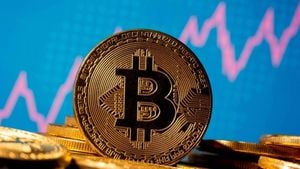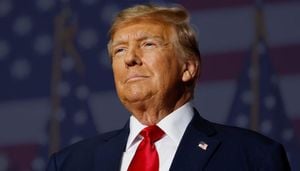What does the prospect of Donald Trump returning to the White House mean for the U.S. economy? Recent analyses suggest dramatic shifts could emerge following his win, as economic sentiment hinges on the regulatory changes and fiscal policies he may pursue. From fluctuated interest rates to potential tariff reforms, experts are weighing the possible outcomes, hoping to decipher the economic weather under Trump’s leadership once again.
According to S&P Global Ratings, which studies such transitions closely, forecasting any significant economic impact at this stage is fraught with uncertainties. They noted, "Any cost or economic projections specific to the Trump campaign’s platform are highly uncertain and difficult to calibrate at this point." This vagueness is elevated by the multitude of Trump’s proposed policies, including tariffs on imports and tax cuts.
The ambiguity surrounding the timing and scale of proposed legal changes presents challenges for businesses, consumers, and investors alike. There’s widespread speculation about tariffs: Trump has discussed significant increases, potentially reaching 10-20% across the board, with even higher rates for imports from China. Such tariffs could invite retaliatory measures, shaping global trade relations unpredictably.
Additionally, economic projections hint at potential reductions to corporate taxes, aiming to entice companies to produce within the U.S. Under Trump’s proposal, the corporate tax rate could drop from 21% to 15%. Such moves might provide short-term boosts, but the longer-term effectiveness remains dubious; S&P suggests these cuts would have limited growth effects as the economy nears full employment.
Trump's policy intentions extend beyond mere taxes and tariffs. Immigration reforms, potentially mass deportations, could also substantially reframe labor dynamics within the country. Critics warn such measures might limit workforce growth, restraining overall economic performance as firms depend on labor to drive expansion.
The ripple effects of these policy changes could extend to housing and mortgage rates, which are pivotal for consumer activity. Currently, the mortgage interest rates have fluctuated wildly, peaking at roughly 8% last October before dropping to around 6.8%. Observers are left wondering how potential changes might impact these rates moving forward, especially with the Federal Reserve's cautious stance on interest-rate adjustments.
The Fed’s moderations are influenced not only by the domestic policies at play but also by global economic sentiment. With Trump’s past leadership characterized by both aggressive deregulation and unpredictable tariffs, analysts predict cautious responses from financial markets. Some investment firms, including Harbour Investment Partners, have begun advising clients proactively about fixing rates before any downturn occurs as confidence wanes.
Jeffrey Triganza, the CEO of Harbour Investment Partners, explains the urgency surrounding the recent projections. He noted, "Our team is seeing a surge in demand for fixed-rate bonds and high-return savings products as investors look to shield themselves from the impact of expected rate cuts." With expectations of rate cuts hovering, the marketplace buzzes with chatter about locking down stable bonds before they potentially vanish.
Analysts highlight the potential for interest rates to plummet under Trump’s policies. This looming reality emphasizes the historical advantages of fixed-rate bonds—considered reliable support systems for savers seeking stability during economic volatility. Given the murky forecasts, experts urge individuals to engage with available high-yield products proactively. Optimistically, for those locked out of the stock market, fixed-income bonds could provide the shelter needed.
Despite the predicted drop-off, expectations of renewed vigor remain tentative; businesses and consumers must navigate uncertainties because both inflation and labor market dynamics are intertwined with policy changes. For example, should tariffs spark inflation, the Fed may have to reconsider its rate structure to stabilize pricing levels. S&P projects, "The erosion of purchasing power from inflation would likely offset the economic benefit of proposed tax cuts, potentially resulting in net drag on output and job creation." This creates yet another layer of complexity.
Investor sentiment has been monitored closely. S&P notes potential jitters as concerns surrounding fiscal sustainability rise. The financial community appears wary of increased term premiums, which could tighten credit accessibility, making it riskier for individuals and corporations to borrow money.
The intersection of these financial predictions paints a dynamic, albeit precarious, picture of the impending economic climate. S&P describes the U.S. markets as "risk-off," reflecting hesitance across sectors anticipating the ramifications of tariffs—both proposed and implemented. Timing is everything, and how swiftly businesses can adapt to shifting sentiments is key.
After Trump’s initial reaction wears off, many wonder how deeply entrenched these policies will become. There’s wide concern among economists about how changes might play out across the board, across economic sectors, and even internationally as Trump's presidency potentially transforms trade patterns.
Though Trump's policies may signal short-term gains for some sectors, opinions are split on the long-term effects. For example, states benefiting from investments due to Biden-era programs like the Inflation Reduction Act (IRA) could see significant pushback against any moves to overrule such frameworks. While proposals to unpick regulations exist, any successful legislative initiative would depend on political backing, particularly within Congress.
Interestingly, even among Republican circles, there’s cautious optimism about maintaining some of the welfare works initiated under Biden's leadership, especially ones benefiting their constituents. The relationship between fiscal reforms and practical governance remains complex, as leaders assess not only political payoffs but also their responsibilities to citizens.
Trump’s administration will likely exploit executive powers to facilitate his trade plans as legal debates around tariff implementation swirl. Advocates suggest this could allow for swifter negotiation, but trade experts raise concerns about the validity and sustainability of such approaches. While there’s support for plans, there’s also resistance building against the ballooning of national debt.
The economic discourse involves numerous layers, from interest rate uncertainties to policies affecting labor and capital. While some analysts predict increased investment stemming from lower corporate taxes, others caution revenues tied to these reforms could be offset by immigration barriers impacting productivity.
The tug-of-war dynamic between reducing unemployment and stimulating growth hinges on the operational strategies leaders choose. Proponents of refining immigration argue it might suffice if appropriately calibrated, ensuring supply meets demand. Achieving such balance becomes more complex as legislative efforts come to limp along amid congressindecisiveness.
Still, up until the election date, the economic climate will remain fluid, introducing new challenges and possibly reshaping our collective financial future. Part of the promise lies within proactivity; it will serve individuals and organizations well to heed expert financial advice as developments progress quicker than anticipated.
Even as predictions about imminent changes sharpen, the advice from firms like Harbour Investment Partners suggests securing favorable investment rates now. For clients tired of following the fluctuative market, taking steps to safeguard their wealth—by considering fixed-rate opportunities—could help steady their financial prospects.
For what lies ahead, the ultimate takeaway may be this: preparation. Economic landscapes are fickle, and as the U.S. braces for the changes under Trump’s leadership, remaining ready is key, whether through investments, tax strategies, or saving preferences. The next few months will be telling as regulations come to light and financial leaders adjust to whatever policies signal the next economic chapter.



